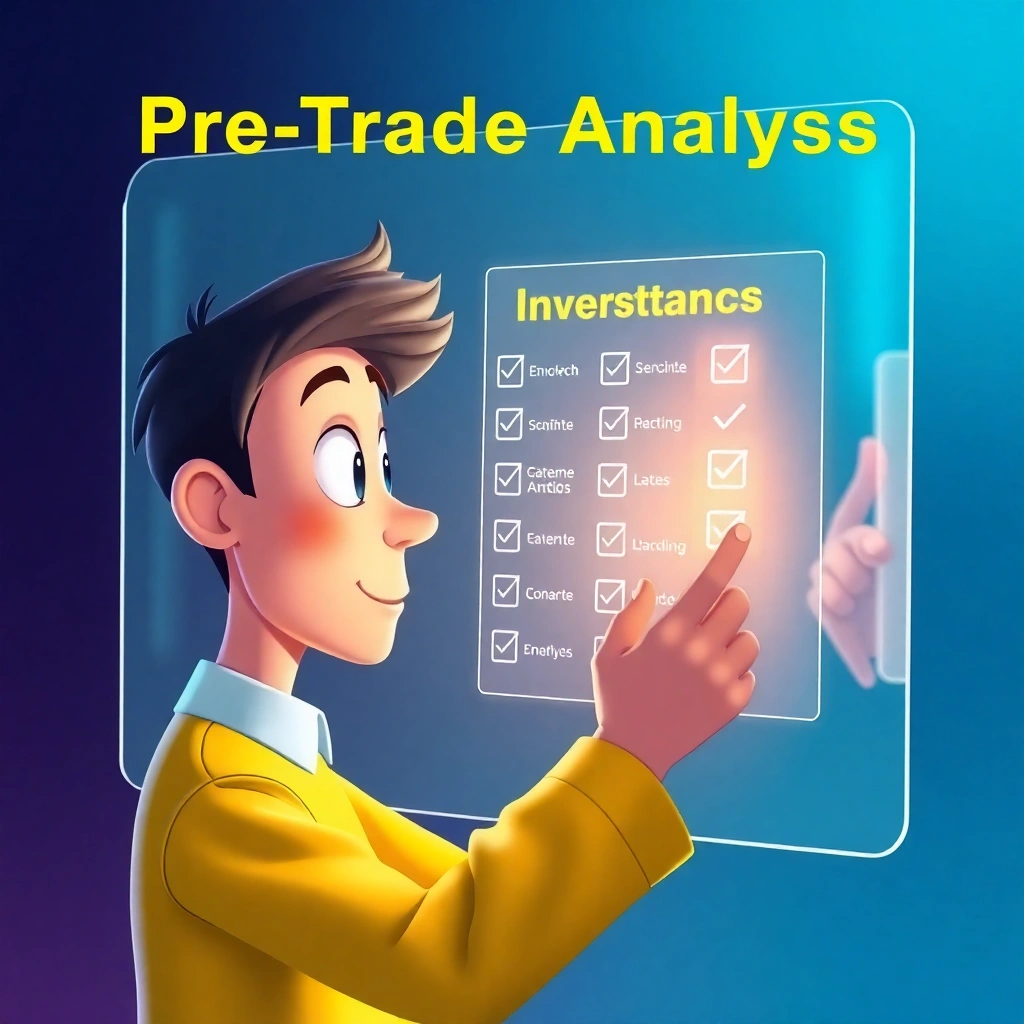Understanding Implied Volatility: A Key to Options Trading
- Introduction: Why Implied Volatility Matters Now
- Implied Volatility Explained: The Market’s Forecast of Future Movement
- Options Pricing Models: A Practical Primer
- The Impact Of Volatility On Options: Premiums, Probabilities, and Payoffs
- How To Analyze Implied Volatility: A Playbook
- IV And Market Sentiment: Reading the Crowd
- Understanding Volatility Trends: Clustering, Regimes, and Seasonality
- Risk Assessment Through IV: Quantifying Uncertainty
- Trading Strategies Using IV: A Framework That Scales
- A Closer Look at IV Metrics: Turning Data into Decisions
- Using Bullish Trade to Analyze and Trade IV
- Two Real-World Scenarios: From Plan to Execution
- Common Myths About IV: What to Avoid
- A Pre-Trade IV Checklist
- Putting It All Together: A Repeatable Process
- Conclusion: Master IV, Master Options

Understanding Implied Volatility: A Key to Options Trading
Unpack the concept of implied volatility and its critical role in options pricing and trading strategies.

Introduction: Why Implied Volatility Matters Now
In options trading, price direction is only half the story. The other half is volatility—specifically, implied volatility (IV). When traders talk about the cost of options, the size of expected moves, the likelihood of a price hitting a strike, or the best strategy to deploy, they’re really talking about volatility. This guide delivers Implied Volatility Explained in plain language, shows the Impact Of Volatility On Options, and gives you practical frameworks for How To Analyze Implied Volatility, Risk Assessment Through IV, and Trading Strategies Using IV. You’ll also see how IV And Market Sentiment are linked, why Understanding Volatility Trends is crucial, and how to build Strategies For High IV to start Trading Volatility Effectively.
Whether you’re new to options or refining a mature process, mastering implied volatility can transform how you choose trades, size them, and manage risk. Along the way, we’ll show you how Bullish Trade—Professional Stock & Options Trading Made Simple—uses AI-powered insights, visual analytics, and automated strategy discovery to make volatility analysis actionable in real time.
Visit Bullish Trade to explore how to put these ideas to work on day one.
Implied Volatility Explained: The Market’s Forecast of Future Movement
- What it is: Implied volatility is the market’s consensus forecast of a stock’s future price fluctuation, derived from options prices. Higher IV means options are more expensive; lower IV means they’re cheaper.
- What it is not: IV is not a guarantee of movement, nor does it predict direction. IV only reflects the expected magnitude of movement.
- Where it comes from: Options pricing models (like Black–Scholes or binomial trees) take inputs—stock price, strike, time to expiration, interest rates, dividends—and an assumed volatility. The market price of an option implies a volatility number when you “back out” that last input. That’s implied volatility.
Implied vs. Historical Volatility
- Historical (realized) volatility measures how much price has moved in the past over a window (e.g., 20 or 30 trading days).
- Implied volatility measures how much the options market expects price to move in the future.
- The IV–HV relationship: IV tends to be higher than HV (a volatility risk premium), reflecting uncertainty and risk tolerance. When IV falls below HV, the market is signaling complacency; when IV rockets far above HV, the market is pricing in event risk or fear.
Why IV Drives Options Prices
- Extrinsic value: A large part of an option’s price is time value, which is heavily influenced by IV.
- Sensitivity (Vega): Vega measures how much an option’s price changes for a 1-point change in IV. Longer-dated options and at-the-money (ATM) options have higher vega.
The takeaway: Any robust options plan requires Implied Volatility Explained at the start. Without IV, you’re trading blind to the true cost and risk.
Options Pricing Models: A Practical Primer
Understanding Options Pricing Models helps you interpret and utilize IV:
- Black–Scholes–Merton (BSM): Widely used for European-style options; assumes lognormal returns, constant volatility, and no early exercise.
- Binomial/Trinomial Trees: Flexible, handle American-style early exercise and changing inputs over time.
- Advanced Models (Heston, SABR, SVI): Account for volatility smiles/skews and stochastic volatility.
In practice:
- Traders don’t input volatility—they observe the option’s market price and solve for IV.
- The “IV surface” maps implied volatility across strikes and expirations. Skew (different IVs by strike) and term structure (different IVs by expiry) reflect real-world risk differences, like crash risk priced into puts.
The Impact Of Volatility On Options: Premiums, Probabilities, and Payoffs
Implied volatility affects:
- Premiums: Higher IV increases both call and put prices, especially near-the-money.
- Probability distribution: Higher IV widens the distribution of expected outcomes—larger potential moves, in either direction.
- Breakevens: Buying options in high IV means higher breakevens; selling options in high IV means larger credits but greater tail risk.
- Strategy Greeks:
- Vega: Long options benefit from rising IV; short options benefit from falling IV.
- Theta: High IV often corresponds to higher theta decay for short premium sellers (good), but also higher extrinsic value paid by buyers (bad unless IV expands).
- Gamma: Event-driven IV boosts gamma for near-term options—great for fast moves, risky if the move doesn’t arrive.
Example (conceptual):
- Stock at 100, 30 days to expiry:
- At 20% IV, an ATM call might be $2.50.
- At 40% IV, the same call might be $4.80. Higher IV means paying nearly double for the same optionality. If you buy options, you want either a bigger/faster move or an IV expansion to justify the cost.
How To Analyze Implied Volatility: A Playbook
Mastery of volatility begins with a consistent framework. Here’s how to analyze implied volatility step-by-step, and where to let the options strategy analyzer turn IV readings into actionable structures.
1) IV Rank and IV Percentile
- IV Rank (IVR): Where current IV sits between its 52-week high and low. If IVR = 70, current IV is higher than 70% of values in the past year.
- IV Percentile (IVP): The percentage of past days when IV was at or below the current level—captures distribution nuances.
Use cases:
- Selling premium: Favor higher IVR/IVP (e.g., > 50–60) to capture richer credits and a potential IV mean reversion.
- Buying premium: Favor lower IVR/IVP (e.g., < 30–40) when you expect a volatility expansion.
2) Term Structure
- Front-month vs. back-month IV: Steep term structure (front IV >> back IV) often signals near-term events (earnings, economic releases).
- Calendar/Diagonal opportunities:
- If front IV is elevated vs. back IV, consider selling front-month premium against a longer-dated anchor (diagonal/calendar).
- If the curve is flat or inverted, be cautious: risk can be spread across months.
3) Skew and Smile
- Put skew: Equity indices often have higher IV for OTM puts (crash risk hedging).
- Call skew: In individual names, call skew can appear near squeezes or supply constraints.
- Strategy alignment: Use skew to choose cost-effective strikes (e.g., buy underpriced wings, sell overpriced wings).

4) Compare IV to HV
- If IV >> HV, the market is pricing larger moves than history suggests—prime for premium selling if catalysts are overestimated.
- If IV << HV, options may be underpricing risk—prime for long premium.
5) Event Context
- Earnings, FDA decisions, product launches, Fed meetings, macro prints: All inflate IV.
- Track pre/post event IV behavior for a name. Some tickers consistently crush IV after earnings; others retain elevated IV due to guidance or litigation.
6) Expected Move Calculation
A simple way to translate IV into price range:
- Approximate expected move over a period = Stock Price × IV × sqrt(Days/365).
- Use it to set strikes for iron condors, strangles, and to evaluate whether a long straddle needs a “bigger-than-priced” move.
7) Liquidity, Open Interest, and Volatility of Volatility (VoV)
- Liquid options with tight spreads make IV analysis reliable.
- Watch how quickly IV itself moves. Rapid rises/falls (high VoV) can sabotage both buyers and sellers.
IV And Market Sentiment: Reading the Crowd
Implied volatility is a real-time gauge of fear, uncertainty, and appetite for risk:
- Rising IV without price declines: Anticipation of a catalyst, hedging demand, or positioning shifts.
- Falling IV with rising price: Risk-on rotation; markets discount danger.
- Divergences: If price grinds higher but IV refuses to drop, someone is buying protection—there may be hidden risks.
For indices, the VIX (implied volatility of S&P 500 options) acts as a market sentiment barometer. Elevated VIX regimes change strategy selection, position sizing, and risk budgets.
Understanding Volatility Trends: Clustering, Regimes, and Seasonality
Volatility clusters—quiet periods stay quiet until an event shakes the market, then elevated volatility can persist. Recognizing volatility regimes helps you avoid mismatched strategies:
- Low-vol regime: Consider longer-dated debit spreads, calendars, long straddles/strangles if expansion is likely.
- High-vol regime: Favor defined-risk premium-selling strategies with prudent wings.
Seasonality matters:
- Earnings cycles produce predictable IV patterns in single names.
- Macro calendars (CPI, FOMC, jobs reports) influence index vol seasonally.
- Summer months can be quieter; October is historically more volatile—contextual, not guaranteed.
Bullish Trade’s seasonality and correlation tools can help visualize these dynamics. Explore them inside the platform.
Risk Assessment Through IV: Quantifying Uncertainty
Implied volatility is a risk lens. Use it to frame:
- Probability ranges: 1 standard deviation covers roughly 68% of expected outcomes under a normal-like distribution. IV helps estimate those boundaries.
- Probability of touch vs. probability of expiring ITM: Touch probability is roughly 2x the probability of finishing ITM for near-the-money strikes over a period—useful for setting credit spreads.
- Tail risk: Skew shows where the market thinks tails are fatter. Steep put skew in equities signals crash risks; be cautious selling naked downside.
- Position Greeks:
- Vega exposure in long/short premium positions.
- Gamma risk near expiration: attractive for quick moves but can be unforgiving.
- Theta decay contribution to returns, especially in high IV.
- Risk-defined construction: Add wings to condors or strangles in very high IV regimes to cap tail risk.
- Portfolio diversification: Consider correlation and cross-asset vol. High index IV often compresses individual name dispersion; low index IV can mask single-name blowups. Anchor every decision with the risk management essentials so your sizing and hedge rules stay consistent.
Trading Strategies Using IV: A Framework That Scales
Let the volatility regime dictate the playbook. Below are Strategies For High IV and strategies for low IV, plus tips for Trading Volatility Effectively in the real world.
Strategies For High IV (Premium Rich, Risk Elevated)
- Short Vertical Credit Spreads (Bear Call/Bull Put)
- Why: Collect richer credits with defined risk; IV crush and theta decay can work in your favor—review the bear call spread playbook for a deeper walkthrough.
- Tips: Sell ~16–30 delta options, 30–45 days to expiration. Add wings (buy further OTM options) to reduce tail risk.
- Iron Condors
- Why: Sell OTM call and put spreads; benefit if price stays within a range and IV falls.
- Tips: Set strikes near or beyond the expected move; consider widening wings in very high IV for better credit and balanced risk.
- Ratio/Back Spreads (Credit-funded)
- Why: Construct positions with positive convexity if the underlying breaks out, while still collecting credit.
- Tips: Requires experience—watch assignment and early exercise risks.
- Diagonals/Calendars in Event IV
- Why: If near-term IV is inflated vs. back-month IV, sell front and buy back month to benefit from IV convergence.
- Tips: Earnings trades often fit this, but be meticulous about skew and expected move.
Risk checkpoints in high IV:
- Scale down size; respect tail risk.
- Prefer defined risk over naked short options.
- Avoid clustering risk across correlated names.
Strategies for Low IV (Options Cheap, Big Moves Underpriced)
- Long Debit Spreads (Bull Call/Bear Put)
- Why: Reduce cost vs. outright long options while keeping directional exposure.
- Tips: Pick expirations that allow time for the thesis; stagger strikes to manage theta.
- Long Straddles/Strangles
- Why: Bet on a volatility expansion or a move larger than priced.
- Tips: Favor catalysts or structural shifts; manage early if IV rises quickly.
- Calendars/Double Calendars
- Why: Exploit low front-month IV with expectation of future IV pickup; harvest time decay while staying defined risk.
- Tips: Evaluate term structure carefully; avoid thinning liquidity.

Trading Volatility Effectively: Practical Rules
- Align Greeks with your thesis: If you expect IV to drop, lean short vega with defined risk. If you expect IV to rise, lean long vega.
- Choose expirations deliberately: Near-term options are more sensitive to gamma and event risk; longer-dated options carry more vega and are less whipsawed.
- Strike selection by delta: A consistent delta framework (e.g., selling 20-delta spreads) stabilizes your expected win rate and risk profile.
- Manage winners early: In high IV, consider taking 50–70% of max credit before the last week to avoid gamma spikes.
- Respect slippage and fees: Wide spreads and illiquid chains can erode edge.
A Closer Look at IV Metrics: Turning Data into Decisions
IV Rank vs. IV Percentile: When to Prefer Which
- IV Rank is simple and widely used; it favors mean-reversion thinking.
- IV Percentile captures how often IV has been lower across the lookback, offering nuance in skewed distributions.
Example:
- Current IV = 32%; 52-week min = 15%; max = 45% ⇒ IVR ≈ 70.
- If the distribution clustered near 28–32% most of the year, IVP might only be ~55. That nuance can change your decision to sell premium aggressively.
Skew as an Opportunity Map
- If put IV is very high relative to call IV, a balanced iron condor can be adjusted by moving the put side wider or closer to improve credit without sacrificing safety.
- In single names with call skew (squeeze risk), consider avoiding short calls close to the money; favor defined risk if you must.
Event Volatility and the “IV Crush”
- Earnings often inflate IV; after the announcement, IV reverts. Selling well-constructed spreads can benefit—if the actual move is within the priced expected move.
- Not all IV crushes are equal. In biotech or legal-risk names, IV can stay elevated post-event. Analyze historical post-event IV decay before committing.
Using Bullish Trade to Analyze and Trade IV
Bullish Trade transforms complex IV analysis into actionable decisions with:
- Automated Options Trade Discovery
- Scans thousands of combinations to find strategies aligned with IV conditions (iron condors for high IV, debit spreads for low IV, calendars around events).
- Set filters for delta, DTE, desired credit/debit, and risk tolerance. The Smart Trade Finder ranks ideas by risk-adjusted returns.
- Visual Company Fundamentals
- Compare peers and industries to see if fundamental catalysts justify elevated or depressed IV.
- Map valuation and growth metrics to potential volatility shifts.
- AI-Powered Assistant
- Ask “How To Analyze Implied Volatility” for a specific ticker and get context-aware insights, including Risk Assessment Through IV.
- Advanced Market Analysis Tools
- Real-time IV, complete options chains with Greeks, open interest, volume, and Unusual Options Activity to detect institutional flows.
- Seasonality patterns and correlation analysis to understand volatility trends across sectors.
- Portfolio & Trade Management
- Simulate P/L under IV shifts; backtest strategies across different volatility regimes.
- Log and evaluate trades to refine your edge.
Try the platform across web and mobile, and start Trading Volatility Effectively directly inside Bullish Trade.
Two Real-World Scenarios: From Plan to Execution
Scenario 1: Earnings Play with Elevated Front-Month IV
- Setup: Stock XYZ trades at 120. One week before earnings, front-month IV jumps from 28% to 60%; back-month IV rises modestly from 26% to 30%.
- Analysis:
- IV Rank ~ high; term structure steep (front >> back).
- Expected move for front week ~ 5.5 points.
- Skew: Puts show higher IV than calls.
- Strategy options:
- Iron Condor: Sell 115/110 puts and 125/130 calls, aiming to straddle the expected move. Defined risk; benefit from IV crush.
- Diagonal Call: Buy 1-month 120 call (30% IV), sell front-week 122 call (60% IV). If the stock stays near 120–122, time decay and IV differential can help.
- Management:
- Close before or shortly after the event to realize IV crush.
- If price tests the short strikes, roll or close to cap risk; avoid gambling through low-probability tails.
Scenario 2: Macro Event with Index Volatility Regime Shift
- Setup: SPX rallies steadily; VIX drifts from 18 to 14. A major CPI report looms.
- Analysis:
- IV is low vs. historical responses to CPI. Market expects small surprise.
- Correlation rising across sectors suggests a single macro driver.
- Strategy options:
- Long Strangle (low IV): If you anticipate a larger-than-priced CPI response, a near-term strangle can benefit from both move and IV expansion.
- Debit Spread: If directional conviction exists (e.g., CPI downside surprise leads to rally), a bull call spread with longer DTE reduces theta bleed.
- Management:
- Scale partial profits on rapid IV expansion or outsized moves.
- Cut quickly if the catalyst underwhelms and IV collapses.
Use the Bullish Trade Smart Trade Finder to compare risk-adjusted returns, and visualize P/L paths under different IV assumptions.
Common Myths About IV: What to Avoid
- “High IV means the stock will drop.” False. IV doesn’t predict direction—just magnitude.
- “IV crush always guarantees profits for sellers.” False. A large directional move can overwhelm crush benefits.
- “Selling premium in high IV is always better.” Not always. Tail risk is elevated; defined risk is often essential.
- “Low IV means nothing will happen.” Markets can transition regimes abruptly—low IV can precede big moves.
- “Skew is noise.” Skew encodes crash risk, short squeeze potential, and hedging demand. Ignore it at your own peril.

A Pre-Trade IV Checklist
Before placing any options trade, run this quick checklist:
- Implied Volatility Explained for the name: Where are IV Rank and Percentile?
- Term structure: Is the front month elevated vs. back months? Any event on the calendar?
- Skew: Are puts or calls overpriced? Position accordingly.
- HV vs. IV: Is the market under- or over-pricing risk relative to history?
- Expected move: Set strikes and targets relative to the expected move.
- Strategy fit: Are you short vega in high IV or long vega in low IV as intended?
- Liquidity: Spreads, open interest, and potential slippage.
- Risk definition: Prefer risk-defined structures when IV is extreme.
- Sizing: Adjust position size for regime risk; correlation clustering can amplify drawdowns.
- Exit plan: Profit targets, stop-losses, and rules for rolling or closing.
Putting It All Together: A Repeatable Process
- Diagnose the volatility regime (IVR/IVP, term structure, skew).
- Map IV to a strategy family (credit spreads, iron condors, diagonals in high IV; debit spreads, long straddles/strangles, calendars in low IV).
- Align Greeks with your thesis (vega, theta, gamma).
- Reference the expected move for strike placement.
- Manage actively: take partials, roll with purpose, and keep risk defined when uncertainty peaks.
Bullish Trade streamlines each step—scanning strategies by IV condition, visualizing IV surfaces and Greeks, and ranking trades by risk-adjusted return—so you can make confident decisions faster.
Conclusion: Master IV, Master Options
Implied volatility is the core language of options. When you understand Implied Volatility Explained, the Impact Of Volatility On Options, How To Analyze Implied Volatility, and the link between IV And Market Sentiment, you gain a decisive edge. You’ll know when Strategies For High IV make sense, when long premium is compelling, and how to conduct Risk Assessment Through IV for every trade. Most importantly, you’ll be Trading Volatility Effectively with a consistent, data-driven process.
If you’re ready to turn volatility insights into smarter trades, let Bullish Trade do the heavy lifting—automated options discovery, AI-powered analysis, and visual fundamentals on one platform. Start your free trial and elevate your trading workflow today at Bullish Trade.
Trade smarter. Control risk. Let volatility work for you.